
Rio 2016 equipment: Women's two person skiffs
The ISAF Equipment Evaluation trials are underway in Santander this week to determine the Women’s 2 person skiff and the mixed multihulls to be used in the Rio 2016 Olympic Games and whether kiteboarding, in any of its many forms, should replace windsurfing.
The six women’s skiff offerings comprise the familiar 29erXX, which is up against the Mackay FX, a 49er with a cutdown female-friendly rig. The Hartley Rebel has been in gestation for a few years now to a design by Phil Morrison and Derek Clarke, while RS are fielding their solid-winged RS900 and Ovington their Dreadnought-bowed skimming dish that is the Aura. As the trials are taking place out of Santander's Prince Felipe High Performance Sailing Centre (Spain’s equivalent of the Weymouth & Portland National Sailing Academy) there are a few 49ers on site to compare with the ladies skiff condidates. Most left field of the proposals is the Arup Skiff - a new Cherub (they have two Aardvark-built Kevin Ellway 6 designs here in Santander) that engineering giant Arup is promising to mass produce if its proposal is selected.
Among the multihulls there are seven participants including the most prolific of all multihulls, if not all boats – the Hobie 16 – plus its big brother the Hobie Tiger F18. They are up against two offerings from Nacra in their newly launched 16 and 17, while the White-Loday clan are in town with their Spitfire S, Carolijn Brouwer is touting the Australian-built Viper F16 and Roland Gaebler is banging the drum for the Tornado to be returned to its rightful place, having been the Olympic catamaran from 1976 until 2008.
Manufacturers and classes are supplying two boats each and MNAs from various countries have offered two sailors per class, so for example Skandia Team GBR’s 470 Women’s reserve team of Penny Clark and Katrina Hughes are jumping between the women’s skiffs while 470 coach Steve Lovegrove and match racer Mary Rook are Britain’s mixed multihull couple.
ISAF is running the evaluation trials scientifically and the MNA sailors have to complete an extensive questionnaire in order to share their thoughts about each boat, commenting upon everything from ease of launching and rigging, to performance and handling upwind, reaching and downwind, looking at everything from sheet loads to how easy/hard tacking and gybing were, to behaviour in waves, capsize recovery, etc etc.
Of course there are all manner of short comings to this and we have heard grumblings ranging from the quality of sailors some of the MNAs have fielded not being up to scratch, to some manufacturers bringing more than two boats, to a week in Santander not providing the necessary range of conditions for a complete evaluation. On Wednesday for example there was no sailing due to a lack of wind.
A bigger concern expressed by many, with long term experience of the ISAF Council and its supreme ability to make appallingly wrong decisions, is that these Equipment Trials may prove to be largely a sop to manufacturers, and that the final decision over the equipment to be used at Rio 2016 (due to be made either at the 2012 ISAF Mid-Year Meeting in Stresa, Italy over 3-6 May or at the full ISAF Conference over 1-11 November in Dublin) will come down to the same behind the scenes political manoeuvring that forced women’s crews into the Yngling and, incredibly, nearly caused the 49er to be ousted at last year’s Mid-Year Meeting.
Women's Two Person Skiff
A most welcome addition this, which frankly should have got in for Beijing.
The ISAF brief is that offerings should be:
- athletically challenging to the elite sailors of the world
- have visual appeal for spectators, media and sailors
- be equipment that avoids unnecessary or excessive costs
- it is desired that the sailors combined weight will be within the 110-130 kg range
- the equipment should not cause a measurement burden on an event organiser.
| 29erXX | Arup Skiff (Cherub) | Aura | Hartley Rebel | Mackay FX | RS900 | |
| LOA | 4.45 | 3.7 | 4.75 | 4.5 | 5 | 4.68 |
| Beam | 1.77 | 1.8 | 2.2 | 3 | 2.74 | 2.83 |
| Weight | 90kg | 68kg | 95kg | 92kg | 130 | 109 |
| Sail area main | 15 | 14.5 | 12.5 | 11.8 | 13.8 | 11.8 |
| Sail area jib | combined | combined | 4.75 | 5.8 | 5.8 | 6 |
| Sail area spi | 19 | 21 | 25ish | 26.75 | 25.1 | 26.6 |
| Price | 10,500 Euros ex tax | £10,500 ex vat | £14,350 inc VAT | £11,995 ex VAT | 17,000-17,200 Euros | N/a |
| Designer | Julian Bethwaite | Kevin Ellway | Peter Hobson | Phil Morrison/Derek Clarke | Julian Bethwaite/Mackay | Phil Morrison/Alex Southern |
| Builder | Various | Rondar/Lightweight Structrues BV | Ovington | Hartley Boats | 49er builders/Mackay Boats | RS |
| First boat launched | 2005 | 2012 | 2011 | 2007/10 | 2011 | 2011 |
| Crew weight | 120-140 | 100-150 | 120 | 120-140 | 120 | 110-130 |
RS900
One of the most anticipated boats for the Women’s Olympic Skiff slot has been the offering from RS in the form their 900. The RS800 was entered into the trials in Hyeres five years ago but RS Managing Director Martin Wadhams (above) says that while it came close, the 800 was a little compromised in that it was designed to be more of an all-round performer, targeting a heavier crew: “It was designed to make skiff sailing as user and club friendly as possible. And we felt the top girls needed a bigger challenge and deserved a boat properly designed for the job.”
So whereas the RS800 optimum crew weight is around 140+kg, for the RS900 it is down to 110-130kg, as laid down in the ISAF spec.
Wadhams also points out that the 800 has performance equalisation, but this was felt to be unsuitable for an Olympic boat. “They see too many difficulties with people weight dipping.”
With a hull design from Phil Morrison and considerable input from RS’s in house Technical Director Alex Southern, one of the first decisions was whether or not to go with a solid wing. Following feedback from sailors they opted to go down this route, with the advantage that in theory this allows a wider beam (in fact the Hartley Rebel has more beam using an 18ft skiff-style tubular double rack arrangement). “That was a big call because they add weight and cost,” says Wadhams of the wings. “For lightweight teams to be able to sail a high performance boat they need leverage and with solid wings you can go quite wide without worrying about wide gaps in the racks.”
Compared to the 800, the 900’s hull is smaller in every way, shorter, narrower on deck and with a lower freeboard, the aim being to keep weight down although it remains one of the heavier boats at the trials. The sail plan has also been modified to keep the centre of effort of the sail plan lower by fitting a jib with a bigger foot length, with the end result that the main is similar in size to the RS800 while the jib and kite are bigger (the kite is now fully masthead at 26.6sqm compared to the RS800’s 21sqm).
In terms of hull design, Wadhams says that there are many of the RS800’s attributes that they wanted to keep such as the boat not being ‘nosey’ “so it feels safer to sail in wind and waves. That is down to more the fore and aft rocker shape – it will sit with the bow up a bit when it is pushed. In theory a straight rocker shape will have a higher top speed, but in practice it means you have to back off otherwise you drive the bow down. Training in the RS800s, we have found that top end speed is not far off 49er speeds, because they are having to back off when the 800 can still really be driven. That surprised all of us...”
Build of the RS900 is in glass with a foam core, and epoxy to increase the lifespan of the boats. There is some local carbon fibre fore and aft reinforcement in a beam within the wings.
The rig is all-new, optimised around the required crew weight range and is fitted with adjustable spreaders. “We think that a bit of adjustability should be allowed, because it will help spread the weight range, so that people can set up the rig to suit them,” says Wadhams. The spars are in carbon from Selden with sails provided by Hyde Sails.
Sail handling is simple and relatively conventional in skiff terms with the Cunningham and kicker led out to the end of the wings. The self tacking jib is operated from a swivel in the centre of the cockpit. Rig tension is applied through a boat breaker and the forestay pinned on the bow, and the jib halyard is on a 2:1 purchase, cleated to the mast.
The rudder is what Wadhams describes as a ‘dagger rudder’ – see the pics. “You can make it a good fit, so it has a solid feel when you are sailing and when you lift the rudder as you are coming ashore, it doesn’t load up so you can steer with half the rudder down.”
Tantalisingly, RS isn’t revealing the price of their 900, although in the presentations that each manufacturer has to make to the Evaluation Panel, it has revealed all. Wadhams also points out that over the opposition, RS is in the privileged position of having an existing infrastructure and an international dealer network and has a track record in production builds. However he adds that they won’t go into production with the RS900 unless it ‘goes Olympic’. “We are under quite a lot of pressure there. At the Dinghy Show people came from Holland to try and persuade us to put it into production.” Wadhams cites that outside of use in the Olympics, demand of this type boat would be quite limited internationally.
 |
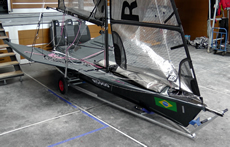 |
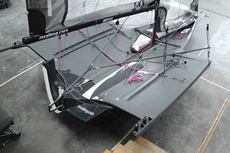 |
 |
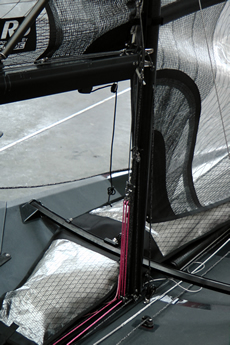 |
 |
 |
Aura
Visually the most appealing with its low freeboard skimming dish looks and particularly the Dreadnought bow is the Aura. This has been conceived by Ovington Boats, which has a long history in these kind of boats as Ner and International 14 builders.
The boat has been designed by relative unknown, Peter Hobson (above), Ovington’s in-house designer, for whom, this is his first commercial design, following his Naval Architecture degree in Newcastle and an apprenticeship at Owen Clarke Design.
Hobson says that what excited him most about the design was that unlike most skiffs (with the exception of the Ners), it didn’t have to fit into a box/length rule. As a result one of the most interesting developments with this boat is that Hobson has borrowed the idea from Nigel Irens’ maxi-tris of focussing on longitudinal stability instead of maximum power for a given length. As a result the Aura has more buoyancy forward (mimicing the same trend in big boat design).
As Hobson explains: “The buoyancy has been drawn quite far forward under the mast base and we put a little bit of rocker under there too. The static waterline is about 1ft back from the bow so when crews get hooked in upwind if they come further forward and start playing with that, it starts to accelerate further and it is encouraging them to actively move about. Rather than them staying in one place we are trying to animate the sailors, which makes it more challenging and more interesting to watch.”
They have also been working on finding the fastest way to sail it downwind and whereas most skiffs are sailed with the crew perched on the transom to coax the bow out, Hobson maintains that with the Aura the aim is the opposite: to keep the bow pressed.
With the design Hobson says he started by defining with the beam of 2.2m (fits into a container, and is towing legal), and only then worked on the sail plan and the hull design.
The Dreadnought bow isn’t wave piercing, but does have some similar properties. “We have found that when we’ve been testing it, that it is not hobby horsing like we see a lot of these boats... We do get water through the boat, but we accepted that right at the beginning, so it is more like a sail board – water goes in, comes out and doesn’t stop. We are pleased with how it performs in a sea way – you can bear away harder without getting that hump where the boat stops and falls over sideways, because it doesn’t hold water. You can bury it nearly as far as the beam and get away with it, which you can’t do on many skiffs and that is just because it can shed water so quickly.”
Unlike the Ners and the RS900, they chose not to go for solid wings to keep it light for the proposed lightweight crew.
Another unique feature of the Aura is that its racks are one piece carbon fibre affairs that are designed to be completely independent of the hull structure. “On most skiffs the wings are trying to tear the decks off and you end up putting more and more structure inside them to try and prevent that,” says Hobson. “As a result the hull construction (in E-Glass and foam sandwich) can be kept quite cheap." In board of this there is a substantial angled surface between hull and deck which forms a comfortable inboard foot position.
The Southern Spars-built rig is more 14-like than 49er in that it is stiffer and has fixed spreaders, which, Hobson maintains, improves acceleration. “It just means that like the 14 and 18 rigs, the sail does all of the work and we’re tending to lock the mast in place and let the sail do all the work. The head of the sail is really quite floppy so all of the gust response happens through the top of the sail and all we are doing through the capshroud tension is changing the bend of the mast to choose when the top of the main will flop off.” Sails are by 49er sail designer Ian MacDiarmid, and generally the Aura’s sail plan seems small compared to the Rebel and the RS900.
The high aspect rudder blade is fitted cassette-style, only that rather than being enclosed in a case the top of the trailing edge is ‘pinched’, locked in place via a purchase system. This is slung off a substantial gantry – which is something they have added since trialling the prototype, in order to get the majority of the tiller out of the cockpit. The gantry increases the Aura’s overall length to 5.1m.
There are all the normal sail controls and some nice details like the turning block fitted to the mast base and the self tacking jib with its track mounted on the front of the rack. The vang has a 32:1 purchase on it to keep loads light and the Cunningham arrangement is similar to that of the 49er.
 |
 |
 |
 |
 |
 |
 |
 |
 |
 |
 |
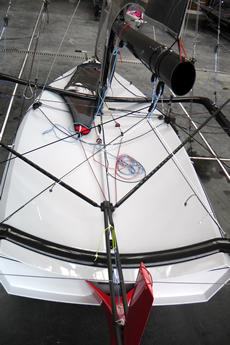 |
 |
 |
 |
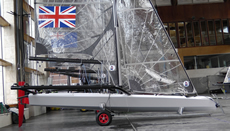 |
We will look at the remainder of the Women's Skiff in part 2 of this article tomorrow.










Latest Comments
Ross Hobson 23/03/2012 - 00:05
love the Aura - has to be the boat of choice for the 2016 Olympics - and it is proving to be as fast if not faster than the opposition. Ross Hobson my totally unbiased few as Pete's V proud Dad ;-)Add a comment - Members log in